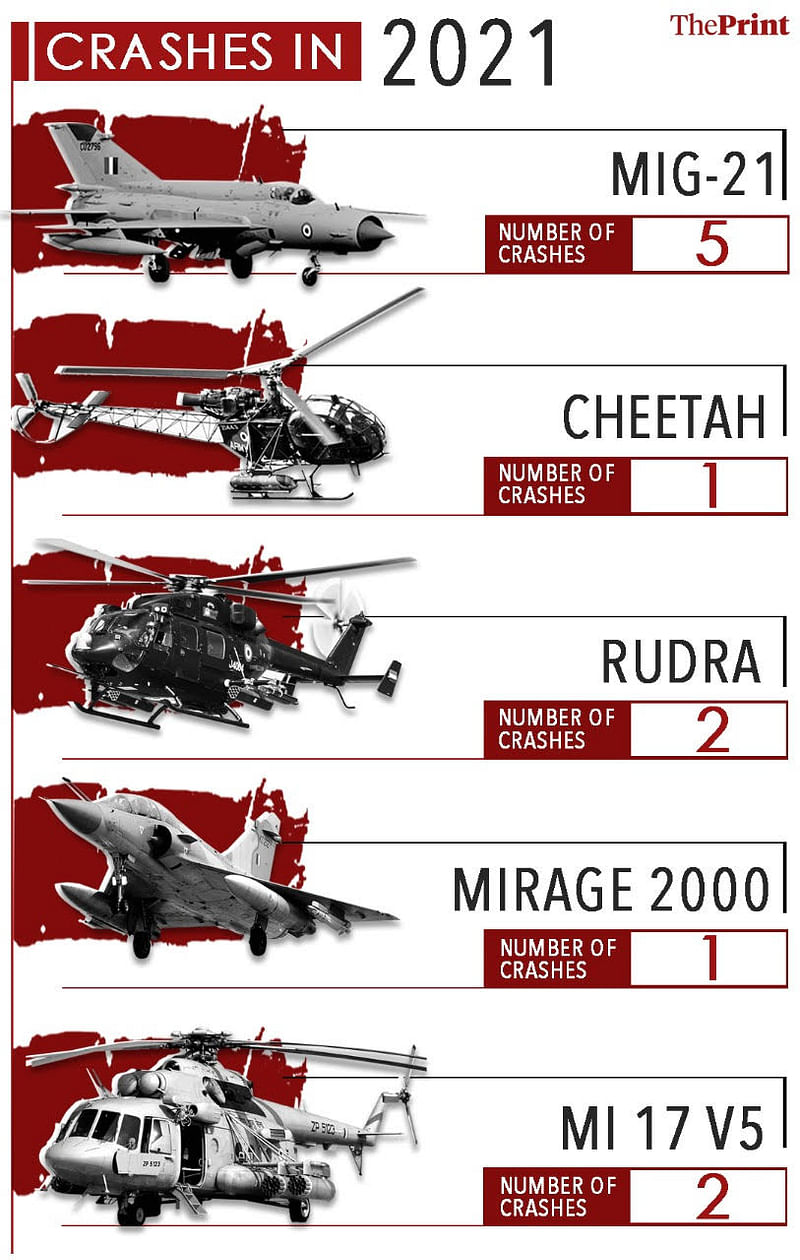2021 A Bloody Year For Military Aviation: CDS Among 22 Dead In 11 Crashes, 5 Involving MiG-21s

New Delhi: The year 2021 has turned out to be one of the bloodiest for India’s military aviation, with 11 crashes resulting in 22 deaths, including that of the country’s first Chief of Defence Staff (CDS) General Bipin Rawat.
The total number of crashes this year is more than twice the number witnessed in 2020. Last year saw five crashes, which led to the deaths of two pilots.
In 2021, the Indian Army and Air Force were hit by multiple crashes that claimed the lives of several young pilots. The Army Aviation Corps, a component of the Indian Army, saw three crashes this year, which claimed the lives of five pilots.
The Navy, however, did not witness any crash of its fleet of helicopters and fighter aircraft.
MiG-21 Bison Involved In 5 Crashes
The MiG-21 Bison was involved in the most number of crashes in 2021, with five. Three pilots lost their lives in these incidents.
The Bison is an upgraded variant of the fighters that were inducted in the 1960s.
In fact, the first incident of 2021 was of a MiG-21 Bison crashing in Rajasthan’s Suratgarh on 5 January. The pilot was able to eject safely.
The latest incident took place earlier this month in Rajasthan’s Jaisalmer, in which Wing Commander Harshit Sinha lost his life.
Apart from the MiG-21 Bison, other aircraft involved in crashes this year included a Mirage-2000 aircraft, two armed versions of Dhruv Advanced Light Helicopters, two Mi-17s and a Cheetah helicopter.

Forces Mum On High Number of Crashes & What Caused Them
While officers from the Army and Air Force remained tight-lipped about the high number of crashes, sources in the defence establishment said they were “within expected levels” when measured against the total flying hours.
“Indian military aircraft fly from cold mountains to the desert and plains. No other military in the world has such diverse flying terrain and weather conditions. Moreover, the aircraft fly a lot, and hence, if taken as a percentage of total flying hours, it is well within the expected levels,” a source said, adding that “every crash is thoroughly probed and remedial actions are taken”.
A Tri-Service Court of Inquiry (CoI) into the tragic crash involving the Mi-17 V5 chopper that killed 14 on board, including CDS Gen Rawat, his wife and other senior officers earlier this month, is already ongoing. Air Chief Marshal V.R. Chaudhari, the head of the IAF, had said that VVIP protocol to fly will be reviewed once the CoI report is submitted.
Sources said the causes of these crashes ranged from weather, human error, technical error to bird hits.
“Let us assume one air force flies 100 hours in a year and one of its aircraft crashes. But another air force flies 10,000 hours and has seen two crashes. In absolute numbers, two is big, but when one calculates the rate of accidents, the latter does not cause any alarm,” a second source explained.
Defence Minister Rajnath Singh had said in 2019 that the accident rate per 10,000 flying hours in the IAF had come down from 1.04 in 1999 to 0.33 in 2019. However, Air Marshal Anil Chopra (Retd), who heads the Centre for Air Power Studies (CAPS), a think tank in Delhi, had in 2013 written that the lowest ever accident rate of 0.22 achieved by the IAF was in 2012, and that was comparable to the most advanced air forces in the world.
Incidentally, the US Air Force had, in 2018, undertaken a complete review after what was termed as an “alarming rate” of crashes and other aviation accidents. This resulted in the numbers reducing in 2019.
Air Force Times had reported last year that the “review zeroed in on several potential risks to aviation safety, including a high operations tempo, a lack of available aircraft, inexperienced maintainers, and a culture that pushes airmen to always execute the mission”.
2019 Was A Bad Year Too
In the recent past, 2019 saw the most number of accidents (16). The numbers included the shooting down of a Mi-17 helicopter in friendly fire, the loss of a MiG-21 Bison in an aerial duel with the Pakistan Air Force, and a mid-air collision involving two Hawk aircraft during practice ahead of the Aero India air show.
In that year, nine pilots were killed in crashes, including two flying the ill-fated Mi-17 V5 that was shot down. The number included a Bhutanese officer who died along with an Indian pilot when their Cheetah chopper crashed.
The 2019 crashes included that of transport aircraft AN-32 in Arunachal Pradesh in June, which led to the death of all 13 on board.



No comments:
Post a Comment